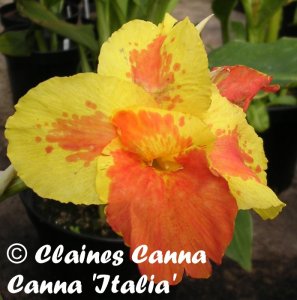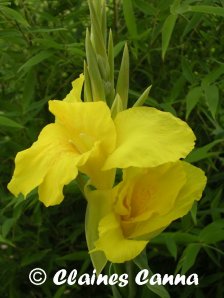Introduced by C. Sprenger, Dammann & Co., Naples, Italy, EU in 1894. Announced along with C. ‘Austria’ in 1894, these two new cultivars caused a sensation at that time, producing much larger flowers than the Crozy Group had been capable of producing. It is a seedling of Canna ‘Madame Crozy’ x C. flaccida.
Category Archives: Italia
Canna ‘Italia’
Introduced by C. Sprenger, Dammann & Co., Naples, Italy, EU in 1894. Announced along with C. ‘Austria’ in 1894, these two new cultivars caused a sensation at that time, producing much larger flowers than the Crozy Group had been capable of producing. It is a seedling of Canna ‘Madame Crozy’ x C. flaccida.
Posted in Carl Sprenger, Italia
Revisiting Canna ‘Italia’
 I just had to share with you this superb illustration taken from the original May 1898 issue of “The Mayflower”,a magazine that I had not heard of before, but which had 273,082 subscribers that is “devoted to the cultivation of flowers and plants, fruits, vegetables, and to gardening and home adornment in general.”
I just had to share with you this superb illustration taken from the original May 1898 issue of “The Mayflower”,a magazine that I had not heard of before, but which had 273,082 subscribers that is “devoted to the cultivation of flowers and plants, fruits, vegetables, and to gardening and home adornment in general.”
The illustration clearly shows the colouring and shows that the labellum (lip) is almost all red and has that distinctive notch in its irregular edge.
Other contents include articles and information on “Evolution of the Canna”, “Cannas Austria and Italia”. All round, this is an informative 111 year old gardening catalog for those interested in the history of Canna.
Canna ‘Italia’
Introduced by C. Sprenger, Dammann & Co., Naples, Italy, EU in 1894. Announced along with C. ‘Austria’ in 1894, these two new cultivars caused a sensation at that time, producing much larger flowers than the Crozy Group had been capable of producing. It is a seedling of Canna ‘Madame Crozy’ x C. flaccida.
Planting outdoors
Revisiting Canna ‘Bavaria’
Introduced by C. Sprenger, Dammann & Co., Naples, Italy, EU in 1897.
In “Notes on the Orchid-flowering Cannas”. Garden & Forest of 29th September 1897, Prof. F. A. Waugh declared that “Italia is a beautiful Canna, to be sure, perhaps the best one of this class yet introduced, but Burgundia and Bavaria are so much like it that a careless observer would pass them by as all of the same kind. Both new varieties are, however, of smaller stature than Italia and have smaller foliage. The flowers in all three are of a brilliant canary-yellow upon which two shades of rich apricot red are successively overlaid. In Italia the red colors are run together in the throat to make somewhat regular solid blotches bordered with very deep bands of the clear yellow, like an exaggerated Queen Charlotte. In Bavaria there is very little of the darker red shade, while the lighter red is scattered in small dots well out upon the petal-like staminodia.”
Synonym: C. ‘Sunburst’
Carl Ludwig Sprenger
Carl Ludwig Sprenger was a German botanist, born on 30 November 1846 at Güstrow, Mecklembourg and died 13 December 1917 on the island of Corfu.
Sprenger lived in Naples from 1877 to 1917, and was a partner in the horticultural house of Dammann & Co. of San Giovanni a Teduccio, Naples, Italy. David Fairchild praised Sprenger, “a brilliant botanist who had established a nursery…he was one of those real plantsmen who both know the names of plants and how to grow them. Sprenger was known to roam mountain sides and meadows. He enthusiastically collected seeds for botanical gardens and freely gave of his knowledge to others.
The eruption of Vesuvius [April 4, 1906] buried his plants under volcanic ash, destroying hundreds of his best specimens.” Sprengers’ life was in ruins.
In 1907, Kaiser Wilhelm (William II) purchased Achilleion, a garden with a palace on Corfu (Kerkyra). Sprenger became supervisor of the Kaiser’s garden.
Sprenger’s life had had no sound; Fairchild wrote that he was “very deaf”. Perhaps he loved plants so much because they spoke in colours, shapes, and scents. In the end, he did not even have flowers. The man who surrounded himself with plants died December 13, 1917, a hostage of war. Being German and living on a Greek island in the middle of the First World War was high-risk, but at 70 years of age he was not prepared to leave behind his beloved plants and move to another country. Nobody was able to establish what really happened, but it is hard to see what threat a 71 year old, deaf, botanist posed that justified his murder.
Canna (Italian Group) ‘Italia’, Sprenger 1893
Sprenger had concluded that by constantly interbreeding the large flowered Crozy varieties nothing novel or more remarkable could be secured, and he, therefore, experimented with some new blood, employing for this purpose the Canna flaccida, a species of the southern USA, of medium height and large flowers, with one specially developed petal. The result was what became known as the ‘Orchid’ Cannas or the ‘Italian’ Cannas. A few years later, Luther Burbank in the USA pursued a similar approach.
- 1893, Canna ‘Italia’ and Canna ‘Austria’
- 1894, Canna ‘Atalanta’, Canna ‘America’, Canna ‘Burgundia’ and Canna ‘Allemaniana’
- 1895, Canna ‘Bavaria’, Canna ‘Britannia’ , Canna ‘Heinrich Seidel’
- 1896, Canna ‘Pandora’
- 1897, Canna ‘Edouard André’, Canna ‘Parthénopé’ and Canna ‘Roma’
- 1907, Canna ‘Wilhelm Bofinger’, Canna ‘Pluto’
- 1909, Canna ‘Roi Humbert’
Sprenger also created and named 122 beautiful Yucca hybrids in the years from 1897 to 1907.
Posted in Austria, Burbank, Italia, Italian Group, Sprenger
Assessment of Canna progress, 1897
 IT is interesting to look back a decade and note the progress made in the cultivation of Cannas. The development of the Crozy type, from which almost every high-class variety has come, is most interesting. In no class of plants can less credit be claimed by the hybridist, for the best Cannas have resulted from careful selection. The arrangements for close fertilization are so complete that it is almost impossible, if fecundation is secured, to thwart Nature.
IT is interesting to look back a decade and note the progress made in the cultivation of Cannas. The development of the Crozy type, from which almost every high-class variety has come, is most interesting. In no class of plants can less credit be claimed by the hybridist, for the best Cannas have resulted from careful selection. The arrangements for close fertilization are so complete that it is almost impossible, if fecundation is secured, to thwart Nature.
It was predicted when the large-flowered giants of the Flaccida type, Italia and Austria, were introduced that they would supersede the Crozy type. Both these types are continuous bloomers, but what is lacking in the blooms of all Cannas, durability of texture, is still more lacking in the Italian varieties. The flowers are extremely fugacious, and what I have seen of the half a dozen or more new colors in this section they all have the same defect. The American variety of this type, the Burbank, is no better in this respect; in appearance it resembles the variety named Austria (see left). As pot-plants for foliage effects Cannas are highly effective, and under glass, with shade, the flowers are more durable. This is true of all Cannas; under glass the flowers have better individual development and last long enough to fill out a good round truss.
Canna specialists hesitate to judge a variety by its behavior under glass; the supreme test is out in the open air. Paul Bruant is superb under glass, but of little use under direct sunlight. For a bedding Canna a compact truss is a strong recommendation. Among medium growers, Queen Charlotte and its ” improved ” variety are the finest. The flowers are widely banded with yellow and durable. An effective combination in a circular bed may be made with plants of Queen Charlotte in the middle and Mrs. Fairman Rogers, a fine form of the Crozy type, as an edging.
Mr. Denys Zirngiebel, of Needham, Massachusetts, who makes a speciality of Cannas, considers President Cleveland, a salmon-scarlet, the finest bedding Canna of its color yet introduced. It is very compact, and in vividness of coloring it outshone all others in a large patch containing sixty varieties. It was raised by Mr. Pfister, gardener at the White House. This list comprises scarcely half a dozen first-class varieties, if the dark-leaved sorts are excluded. Bismarck, a recent variety, showed up well; it has a dwarf habit and compact and full-flowered truss of crimson flowers. Robert Christie is a beautiful salmon-red and a splendid pot-plant; Ami Pichon is a good maroon with deeper spots; Leonard Vaughan is a fine dark-leaved kind with scarlet flowers; J. D. Cabos has orange-scarlet blooms; President Carnot has luxuriant foliage.
Wellesley, Mass. – Professor T. D. Hatfield.
Pandora’s box of tricks, 1897
 PANDORA is another of the Orchid-flowering Cannas from the list of Dammann & Co. We have the variety from the originators, and have been enjoying its blossoms in the greenhouse since September. The plant is dwarf, growing about three feet high. But these are young plants closely potted in the house, so that we may expect a larger growth of strong plants out-of-doors. The foliage is very dark red, splashed with lighter greenish red. The flowers most closely resemble those of America, described in GARDEN AND FOREST, vol. x., p. I78, with the attractive, full-rounded form of those of Italia, with reflexed petals (not staminodia). The petal-like staminodia are bright, fiery cherry-red, heavily splashed and overlaid with a darker velvety red, giving a peculiarly rich appearance. Pandora and America please us the best of all the Italian or Orchid-flowering sorts.
PANDORA is another of the Orchid-flowering Cannas from the list of Dammann & Co. We have the variety from the originators, and have been enjoying its blossoms in the greenhouse since September. The plant is dwarf, growing about three feet high. But these are young plants closely potted in the house, so that we may expect a larger growth of strong plants out-of-doors. The foliage is very dark red, splashed with lighter greenish red. The flowers most closely resemble those of America, described in GARDEN AND FOREST, vol. x., p. I78, with the attractive, full-rounded form of those of Italia, with reflexed petals (not staminodia). The petal-like staminodia are bright, fiery cherry-red, heavily splashed and overlaid with a darker velvety red, giving a peculiarly rich appearance. Pandora and America please us the best of all the Italian or Orchid-flowering sorts.


The varieties Bavaria and Burgundia (Dammann) have also been in blossom with us since September 13th. These are both of comparatively dwarf habit, the foliage being smaller and narrower than in the better-known Italia, Austria and Burbank. They both give blossoms of the Italia type, it being frequently difficult or entirely impossible to separate the three, Bavaria, Burgundia and Italia, by the blossoms alone. Bavaria tends to have more solid red at the centre, so that it becomes rather a yellow-bordered flower, of somewhat the same marking as Queen Charlotte; Burgundia is more spotted and looks a trifle more like Florence Vaughan; Bavaria usually has upright petals, while Burgundia commonly shows its Canna flaccida parentage in reflexed petals. We had Italia and Austria in large beds on the open lawn throughout the summer, where they gave moderate satisfaction. Their large growth and heavy luxuriant leaves give a fresh, semitropical foliage effect worth consideration; but the blossoms are not, upon outdoor plants, an item of much importance.
University of Vermont. Professor F. A. Waugh.
New Italian cultivars
 WE have been greatly interested in the new Orchid-flowering Cannas since their first announcement, and have taken some pains to grow most of the varieties offered for sale. A note regarding the variety America was sent to GARDEN AND FOREST some weeks ago (see vol. x., page I78), and a completer account has been more recently published in the Tenth Annual Report of the Vermont Experiment Station, page 119. Since that report went to press we have brought two new varieties of these Cannas into blossom. These are Bavaria and Burgundia, both from the lists of Dammann & Co., the originators of Italia, Austria and America. We are somewhat disappointed in these two newest varieties, not because of bad qualities, but on account of their close resemblance to Italia. Italia is a beautiful Canna, to be sure, perhaps the best one of this class yet introduced, but Burgundia and Bavaria are so much like it that a careless observer would pass them by as all of the same kind.
WE have been greatly interested in the new Orchid-flowering Cannas since their first announcement, and have taken some pains to grow most of the varieties offered for sale. A note regarding the variety America was sent to GARDEN AND FOREST some weeks ago (see vol. x., page I78), and a completer account has been more recently published in the Tenth Annual Report of the Vermont Experiment Station, page 119. Since that report went to press we have brought two new varieties of these Cannas into blossom. These are Bavaria and Burgundia, both from the lists of Dammann & Co., the originators of Italia, Austria and America. We are somewhat disappointed in these two newest varieties, not because of bad qualities, but on account of their close resemblance to Italia. Italia is a beautiful Canna, to be sure, perhaps the best one of this class yet introduced, but Burgundia and Bavaria are so much like it that a careless observer would pass them by as all of the same kind.

University of Vermont. F. A. Waugh.







